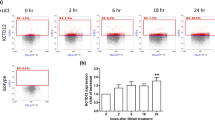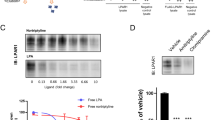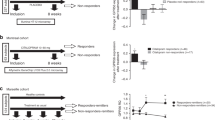Abstract
Psychotropic medications target glycogen synthase kinase 3β (GSK3β), but the functional integration with other factors relevant for drug efficacy is poorly understood. We discovered that the suggested psychiatric risk factor FK506 binding protein 51 (FKBP51) increases phosphorylation of GSK3β at serine 9 (pGSK3βS9). FKBP51 associates with GSK3β mainly through its FK1 domain; furthermore, it also changes GSK3β's heterocomplex assembly by associating with the phosphatase PP2A and the kinase cyclin-dependent kinase 5. FKBP51 acts through GSK3β on the downstream targets Tau, β-catenin and T-cell factor/lymphoid enhancing factor (TCF/LEF). Lithium and the antidepressant (AD) paroxetine (PAR) functionally synergize with FKBP51, as revealed by reporter gene and protein association analyses. Deletion of FKBP51 blunted the PAR- or lithium-induced increase in pGSK3βS9 in cells and mice and attenuated the behavioral effects of lithium treatment. Clinical improvement in depressive patients was predicted by baseline GSK3β pathway activity and by pGSK3βS9 reactivity to ex vivo treatment of peripheral blood mononuclear lymphocytes with lithium or PAR. In sum, FKBP51-directed GSK3β activity contributes to the action of psychotropic medications. Components of the FKBP51–GSK3β pathway may be useful as biomarkers predicting AD response and as targets for the development of novel ADs.
This is a preview of subscription content, access via your institution
Access options
Subscribe to this journal
Receive 12 print issues and online access
$259.00 per year
only $21.58 per issue
Buy this article
- Purchase on Springer Link
- Instant access to full article PDF
Prices may be subject to local taxes which are calculated during checkout





Similar content being viewed by others
References
Cohen P, Frame S . The renaissance of GSK3. Nat Rev Mol Cell Biol 2001; 2: 769–776.
Hur EM, Zhou FQ . GSK3 signalling in neural development. Nat Rev Neurosci 2010; 11: 539–551.
Doble BW, Woodgett JR . GSK-3: tricks of the trade for a multi-tasking kinase. J Cell Sci 2003; 116: 1175–1186.
Harwood AJ . Regulation of GSK-3: a cellular multiprocessor. Cell 2001; 105: 821–824.
Cross DA, Alessi DR, Cohen P, Andjelkovich M, Hemmings BA . Inhibition of glycogen synthase kinase-3 by insulin mediated by protein kinase B. Nature 1995; 378: 785–789.
Goode N, Hughes K, Woodgett JR, Parker PJ . Differential regulation of glycogen synthase kinase-3 beta by protein kinase C isotypes. J Biol Chem 1992; 267: 16878–16882.
Li M, Wang X, Meintzer MK, Laessig T, Birnbaum MJ, Heidenreich KA . Cyclic AMP promotes neuronal survival by phosphorylation of glycogen synthase kinase 3beta. Mol Cell Biol 2000; 20: 9356–9363.
Plattner F, Angelo M, Giese KP . The roles of cyclin-dependent kinase 5 and glycogen synthase kinase 3 in Tau hyperphosphorylation. J Biol Chem 2006; 281: 25457–25465.
Morfini G, Szebenyi G, Brown H, Pant HC, Pigino G, DeBoer S et al. A novel CDK5-dependent pathway for regulating GSK3 activity and kinesin-driven motility in neurons. EMBO J 2004; 23: 2235–2245.
Louis JV, Martens E, Borghgraef P, Lambrecht C, Sents W, Longin S et al. Mice lacking phosphatase PP2A subunit PR61/B'delta (Ppp2r5d) develop spatially restricted Tauopathy by deregulation of CDK5 and GSK3beta. Proc Natl Acad Sci USA 2011; 108: 6957–6962.
Hallows JL, Chen K, DePinho RA, Vincent I . Decreased cyclin-dependent kinase 5 (Cdk5) activity is accompanied by redistribution of Cdk5 and cytoskeletal proteins and increased cytoskeletal protein phosphorylation in P35 null mice. J Neurosci 2003; 23: 10633–10644.
Karege F, Perroud N, Burkhardt S, Schwald M, Ballmann E, La HR et al. Alteration in kinase activity but not in protein levels of protein kinase B and glycogen synthase kinase-3beta in ventral prefrontal cortex of depressed suicide victims. Biol Psychiatry 2007; 61: 240–245.
O'Brien WT, Harper AD, Jove F, Woodgett JR, Maretto S, Piccolo S et al. Glycogen synthase kinase-3beta haploinsufficiency mimics the behavioral and molecular effects of lithium. J Neurosci 2004; 24: 6791–6798.
Beaulieu JM, Marion S, Rodriguiz RM, Medvedev IO, Sotnikova TD, Ghisi V et al. A beta-arrestin 2 signaling complex mediates lithium action on behavior. Cell 2008; 132: 125–136.
Omata N, Chiu CT, Moya PR, Leng Y, Wang Z, Hunsberger JG et al. Lentivirally mediated GSK-3beta silencing in the hippocampal dentate gyrus induces antidepressant-like effects in stressed mice. Int J Neuropsychopharmacol 2011; 14: 711–717.
Rosa AO, Kaster MP, Binfare RW, Morales S, Martin-Aparicio E, Navarro-Rico ML et al. Antidepressant-like effect of the novel thiadiazolidinone NP031115 in mice. Prog Neuropsychopharmacol Biol Psychiatry 2008; 32: 1549–1556.
Polter A, Beurel E, Yang S, Garner R, Song L, Miller CA et al. Deficiency in the inhibitory serine-phosphorylation of glycogen synthase kinase-3 increases sensitivity to mood disturbances. Neuropsychopharmacology 2010; 35: 1761–1774.
Li X, Jope RS . Is glycogen synthase kinase-3 a central modulator in mood regulation? Neuropsychopharmacology 2010; 35: 2143–2154.
Polter AM, Yang S, Jope RS, Li X . Functional significance of glycogen synthase kinase-3 regulation by serotonin. Cell Signal 2012; 24: 265–271.
Nivoli AM, Murru A, Vieta E . Lithium: still a cornerstone in the long-term treatment in bipolar disorder? Neuropsychobiology 2010; 62: 27–35.
Jope RS . Lithium and GSK-3: one inhibitor, two inhibitory actions, multiple outcomes. Trends Pharmacol Sci 2003; 24: 441–443.
Binder EB, Bradley RG, Liu W, Epstein MP, Deveau TC, Mercer KB et al. Association of FKBP5 polymorphisms and childhood abuse with risk of posttraumatic stress disorder symptoms in adults. JAMA 2008; 299: 1291–1305.
Klengel T, Mehta D, Anacker C, Rex-Haffner M, Pruessner JC, Pariante CM et al. Allele-specific FKBP5 DNA demethylation mediates gene-childhood trauma interactions. Nat Neurosci 2013; 16: 33–41.
Lekman M, Laje G, Charney D, Rush AJ, Wilson AF, Sorant AJ et al. The FKBP5-gene in depression and treatment response—an Association Study in the Sequenced Treatment Alternatives to Relieve Depression (STAR*D) Cohort. Biol Psychiatry 2008; 63: 1103–1110.
Willour VL, Chen H, Toolan J, Belmonte P, Cutler DJ, Goes FS et al. Family-based association of FKBP5 in bipolar disorder. Mol Psychiatry 2008; 14: 261–268.
Binder EB, Salyakina D, Lichtner P, Wochnik GM, Ising M, Putz B et al. Polymorphisms in FKBP5 are associated with increased recurrence of depressive episodes and rapid response to antidepressant treatment. Nat Genet 2004; 36: 1319–1325.
Wochnik GM, Rüegg J, Abel GA, Schmidt U, Holsboer F, Rein T . FK506-binding proteins 51 and 52 differentially regulate dynein interaction and nuclear translocation of the glucocorticoid receptor in mammalian cells. J Biol Chem 2005; 280: 4609–4616.
Riggs DL, Roberts PJ, Chirillo SC, Cheung-Flynn J, Prapapanich V, Ratajczak T et al. The Hsp90-binding peptidylprolyl isomerase FKBP52 potentiates glucocorticoid signaling in vivo. EMBO J 2003; 22: 1158–1167.
Pei H, Li L, Fridley BL, Jenkins GD, Kalari KR, Lingle W et al. FKBP51 affects cancer cell response to chemotherapy by negatively regulating Akt. Cancer Cell 2009; 16: 259–266.
Jinwal UK, Koren J III, Borysov SI, Schmid AB, Abisambra JF, Blair LJ et al. The Hsp90 cochaperone, FKBP51, increases Tau stability and polymerizes microtubules. J Neurosci 2010; 30: 591–599.
Chambraud B, Sardin E, Giustiniani J, Dounane O, Schumacher M, Goedert M et al. A role for FKBP52 in Tau protein function. Proc Natl Acad Sci USA 2010; 107: 2658–2663.
Quinta HR, Maschi D, Gomez-Sanchez C, Piwien-Pilipuk G, Galigniana MD . Subcellular rearrangement of Hsp90-binding immunophilins accompanies neuronal differentiation and neurite outgrowth. J Neurochem 2010; 115: 716–734.
Touma C, Gassen NC, Herrmann L, Cheung-Flynn J, Bull DR, Ionescu IA et al. FK506 binding protein 5 shapes stress responsiveness: modulation of neuroendocrine reactivity and coping behavior. Biol Psychiatry 2011; 70: 928–936.
Kapoor M, Liu S, Shi-wen X, Huh K, McCann M, Denton CP et al. GSK-3beta in mouse fibroblasts controls wound healing and fibrosis through an endothelin-1-dependent mechanism. J Clin Invest 2008; 118: 3279–3290.
Schumann BG, Jutzi P, Roditi I . Genome-wide RNAi screens in bloodstream form trypanosomes identify drug transporters. Mol Biochem Parasitol 2011; 175: 91–94.
van den HS, Harlow E . Distinct roles for cyclin-dependent kinases in cell cycle control. Science 1993; 262: 2050–2054.
Veeman MT, Slusarski DC, Kaykas A, Louie SH, Moon RT . Zebrafish prickle, a modulator of noncanonical Wnt/Fz signaling, regulates gastrulation movements. Curr Biol 2003; 13: 680–685.
Schülke JP, Wochnik GM, Lang-Rollin I, Gassen NC, Knapp RT, Berning B et al. Differential impact of tetratricopeptide repeat proteins on the steroid hormone receptors. PLoS One 2010; 5: e11717.
Gassen NC, Hartmann J, Zschocke J, Stepan J, Hafner K, Zellner A et al. Association of FKBP51 with priming of autophagy pathways and mediation of antidepressant treatment response: evidence in cells, mice, and humans. PLoS Med 2014; 11: e1001755.
Bowley E, Mulvihill E, Howard JC, Pak BJ, Gan BS, O'Gorman DB . A novel mass spectrometry-based assay for GSK-3beta activity. BMC Biochem 2005; 6: 29.
Tranguch S, Cheung-Flynn J, Daikoku T, Prapapanich V, Cox MB, Xie H et al. Cochaperone immunophilin FKBP52 is critical to uterine receptivity for embryo implantation. Proc Natl Acad Sci USA 2005; 102: 14326–14331.
Gillespie CF, Bradley B, Mercer K, Smith AK, Conneely K, Gapen M et al. Trauma exposure and stress-related disorders in inner city primary care patients. Gen Hosp Psychiatry 2009; 31: 505–514.
Huber W, von HA, Sultmann H, Poustka A, Vingron M . Variance stabilization applied to microarray data calibration and to the quantification of differential expression. Bioinformatics 2002; 18: S96–S104.
Johnson WE, Li C, Rabinovic A . Adjusting batch effects in microarray expression data using empirical Bayes methods. Biostatistics 2007; 8: 118–127.
Hennings JM, Owashi T, Binder EB, Horstmann S, Menke A, Kloiber S et al. Clinical characteristics and treatment outcome in a representative sample of depressed inpatients - findings from the Munich Antidepressant Response Signature (MARS) project. J Psychiatr Res 2009; 43: 215–229.
APA Diagnostic and Statistical Manual of Mental Disorders: DSM-IV-TR 4th edn. American Psychiatric Association: Washington, DC, 1994.
Overall JE, Rhoades HM . Use of the Hamilton Rating Scale for classification of depressive disorders. Compr Psychiatry 1982; 23: 370–376.
Perisic T, Zimmermann N, Kirmeier T, Asmus M, Tuorto F, Uhr M et al. Valproate and amitriptyline exert common and divergent influences on global and gene promoter-specific chromatin modifications in rat primary astrocytes. Neuropsychopharmacology 2010; 35: 792–805.
Zimmermann N, Perisic T, Hafner K, Uhr M, Holsboer E, Zschocke J et al. The epigenetic machinery of neural cells Is modulated by psychoactive drugs. Eur Neuropsychopharmacol 2011; 21: S21–S22.
Franke B, Figiel M, Engele J . CNS glia are targets for GDNF and neurturin. Histochem Cell Biol 1998; 110: 595–601.
Hiemke C, Baumann P, Bergemann N, Conca A, Dietmaier O, Egberts K et al. AGNP consensus guidelines for therapeutic drug monitoring in psychiatry: update 2011. Pharmacopsychiatry 2011; 44: 195–235.
Kapfhamer D, Berger KH, Hopf FW, Seif T, Kharazia V, Bonci A et al. Protein phosphatase 2a and glycogen synthase kinase 3 signaling modulate prepulse inhibition of the acoustic startle response by altering cortical M-type potassium channel activity. J Neurosci 2010; 30: 8830–8840.
Bourin M, Chue P, Guillon Y . Paroxetine: a review. CNS Drug Rev 2001; 7: 25–47.
Silva MF, Aires CC, Luis PB, Ruiter JP, IJlst L, Duran M et al. Valproic acid metabolism and its effects on mitochondrial fatty acid oxidation: a review. J Inherit Metab Dis 2008; 31: 205–216.
Lopes JP, Agostinho P . Cdk5: multitasking between physiological and pathological conditions. Prog Neurobiol 2011; 94: 49–63.
Hartmann J, Wagner KV, Liebl C, Scharf SH, Wang XD, Wolf M et al. The involvement of FK506-binding protein 51 (FKBP5) in the behavioral and neuroendocrine effects of chronic social defeat stress. Neuropharmacology 2012; 62: 332–339.
Wang XD, Chen Y, Wolf M, Wagner KV, Liebl C, Scharf SH et al. Forebrain CRHR1 deficiency attenuates chronic stress-induced cognitive deficits and dendritic remodeling. Neurobiol Dis 2011; 42: 300–310.
Berton O, McClung CA, Dileone RJ, Krishnan V, Renthal W, Russo SJ et al. Essential role of BDNF in the mesolimbic dopamine pathway in social defeat stress. Science 2006; 311: 864–868.
Nestler EJ, Hyman SE . Animal models of neuropsychiatric disorders. Nat Neurosci 2010; 13: 1161–1169.
Failor KL, Desyatnikov Y, Finger LA, Firestone GL . Glucocorticoid-induced degradation of glycogen synthase kinase-3 protein is triggered by serum- and glucocorticoid-induced protein kinase and Akt signaling and controls beta-catenin dynamics and tight junction formation in mammary epithelial tumor cells. Mol Endocrinol 2007; 21: 2403–2415.
Barabasi AL, Gulbahce N, Loscalzo J . Network medicine: a network-based approach to human disease. Nat Rev Genet 2011; 12: 56–68.
Visscher PM, Brown MA, McCarthy MI, Yang J . Five years of GWAS discovery. Am J Hum Genet 2012; 90: 7–24.
Di PR, Caporarello N, Marucci A, Dimatteo C, Iadicicco C, Del GS et al. ENPP1 affects insulin action and secretion: evidences from in vitro studies. PLoS One 2011; 6: e19462.
Dunleavy M, Provenzano G, Henshall DC, Bozzi Y . Kainic acid-induced seizures modulate Akt (SER473) phosphorylation in the hippocampus of dopamine D2 receptor knockout mice. J Mol Neurosci 2013; 49: 202–210.
Jacinto E, Facchinetti V, Liu D, Soto N, Wei S, Jung SY et al. SIN1/MIP1 maintains rictor-MTOR complex integrity and regulates Akt phosphorylation and substrate specificity. Cell 2006; 127: 125–137.
Garza JC, Guo M, Zhang W, Lu XY . Leptin restores adult hippocampal neurogenesis in a chronic unpredictable stress model of depression and reverses glucocorticoid-induced inhibition of GSK-3beta/beta-catenin signaling. Mol Psychiatry 2012; 17: 790–808.
De Kloet ER, Joels M, Holsboer F . Stress and the brain: from adaptation to disease. Nat Rev Neurosci 2005; 6: 463–475.
Schmidt MV, Schülke JP, Liebl C, Stiess M, Avrabos C, Bock J et al. Tumor suppressor down-regulated in renal cell carcinoma 1 (DRR1) is a stress-induced actin bundling factor that modulates synaptic efficacy and cognition. Proc Natl Acad Sci USA 2011; 108: 17213–17218.
O'Leary JC III, Dharia S, Blair LJ, Brady S, Johnson AG, Peters M et al. A new anti-depressive strategy for the elderly: ablation of FKBP5/FKBP51. PLoS One 2011; 6: e24840.
Gaali S, Kirschner A, Cuboni S, Hartmann J, Kozany C, Balsevich G et al. Selective inhibitors of the FK506-binding protein 51 by induced fit. Nat Chem Biol 2014; 11: 33–37.
Gould TD, Manji HK . Glycogen synthase kinase-3: a putative molecular target for lithium mimetic drugs. Neuropsychopharmacology 2005; 30: 1223–1237.
Jope RS . Glycogen synthase kinase-3 in the etiology and treatment of mood disorders. Front Mol Neurosci 2011; 4: 16.
Wagner KV, Marinescu D, Hartmann J, Wang XD, Labermaier C, Scharf SH et al. Differences in FKBP51 regulation following chronic social defeat stress correlate with individual stress sensitivity: influence of paroxetine treatment. Neuropsychopharmacology 2012; 37: 2797–2808.
Wagner KV, Wang XD, Liebl C, Scharf SH, Muller MB, Schmidt MV . Pituitary glucocorticoid receptor deletion reduces vulnerability to chronic stress. Psychoneuroendocrinology 2011; 36: 579–587.
Acknowledgements
We thank Daniela Harbich and Bianca Schmid for their excellent technical support. We are indebted to James Woodgett, University of Toronto, for contributing the GSK3β KO cells. We thank Kerry Ressler (Emory University) and the Grady Trauma Projekt investigators for providing RNA data.
Author Contributions
Molecular and cellular experiments: NCG, KH. Animal experiments: JH, MVS. Kinase assay: AZ. Proteomics: GM, CWT. Protein purification: AK. Clinical sample: ASZ, SK, SL, FH, EBB, MI. Statistics: MI, NCG, JH. Design of study: NCG, TR, with important input from JZ, MVS, JH. Manuscript writing: TR, NCG. Editing: JH, MI, MVS, JZ, FH, EBB, GPC, LKK. All authors have seen the manuscript and contributed suggestions.
Author information
Authors and Affiliations
Corresponding authors
Ethics declarations
Competing interests
The authors declare no conflict of interest.
Additional information
Supplementary Information accompanies the paper on the Molecular Psychiatry website
Supplementary information
Rights and permissions
About this article
Cite this article
Gassen, N., Hartmann, J., Zannas, A. et al. FKBP51 inhibits GSK3β and augments the effects of distinct psychotropic medications. Mol Psychiatry 21, 277–289 (2016). https://doi.org/10.1038/mp.2015.38
Received:
Revised:
Accepted:
Published:
Issue Date:
DOI: https://doi.org/10.1038/mp.2015.38
This article is cited by
-
Tricyclic antidepressants target FKBP51 SUMOylation to restore glucocorticoid receptor activity
Molecular Psychiatry (2022)
-
The co-chaperone Fkbp5 shapes the acute stress response in the paraventricular nucleus of the hypothalamus of male mice
Molecular Psychiatry (2021)
-
SKP2 attenuates autophagy through Beclin1-ubiquitination and its inhibition reduces MERS-Coronavirus infection
Nature Communications (2019)
-
Stress-responsive FKBP51 regulates AKT2-AS160 signaling and metabolic function
Nature Communications (2017)



